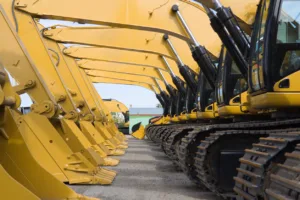Landlords and tenants squabbling over make good costs in commercial leases should consider this dispute relating to an industrial warehouse leased to a heavy machinery hire company.
Kingston Industries took up occupation of the western Sydney premises in August 2010 and after its lease extensions expired in July 2017, it continued occupation on a month-to-month basis until December that year.
 Landlord Diana Morabito claimed Kingston was responsible for the make good cost of replacing concrete surfaces in the warehouse and the car park which she claimed had been shattered by the tenant’s steel track earthmoving equipment.
Landlord Diana Morabito claimed Kingston was responsible for the make good cost of replacing concrete surfaces in the warehouse and the car park which she claimed had been shattered by the tenant’s steel track earthmoving equipment.
She demanded the former tenant pay $344,000 in make good costs plus lost rent of $295,000 for the 18-month period between when Kingston departed and the date the premises were re-let in June 2019.
The lease – which specified a permitted use of “Plant Hire/Distribution” – contained the usual provisions in relation to the tenant’s maintenance and repair obligations but excluded damage caused by the landlord’s negligence or which occurred “outside its control” from the realm of tenant’s responsibility.
The terms also prohibited the tenant from “allowing the floor to be broken or damaged by overloading”.
The landlord was obliged to “maintain the structure of the premises in good repair” but it gave no warranty or representation that they were suitable for the tenant’s use.
When Kingston refused to pay, the landlord filed proceedings to recover her make good costs in the NSW Supreme Court.
Morabito contended that the permitted use did not extend to moving steel tracked equipment on the concrete surfaces without using protective measures of mapping or steel plates.
Justice Elisabeth Peden had to consider whether machinery with steel tracks was “plant”- and therefore permitted – that would ordinarily be expected to be moved around.
She saw no need to resort to the principle that lease covenants including those in relation to permitted use “are strictly construed against a lessor” because the word “plant” unambiguously included the tenant’s steel tracked equipment – some of over 22 tonnes in weight – of which the landlord had been aware.
Suspecting that the concrete surfaces were defective, Kingston engaged engineers to inspect and test the damaged paving.
Kingston managed to locate Fernando Algorry, the engineer who originally designed the concrete surfaces who swore that – because he was not provided with instructions about the type required – he had adopted a standard specification for concrete suitable for light to medium industry and machinery with pneumatic tyres only.
He also attested that the concrete supplied to the job – by reference to the few cartage delivery documents the landlord produced in discovery – was even inferior to the grade of product he had specified.
And had he known what was actually supplied, he “would not have certified” the low grade concrete that had been supplied.
This allowed Kingston to argue the failure in the concrete fell into one of the exceptions to its maintenance and repair obligations because it was caused by the landlord’s negligence; beyond its control; or it had occurred as a result of “fair wear and tear”.
Justice Peden accepted Kingston’s submission that Ms Morabito’s failure to produce many missing cement truck delivery dockets entitled the court to conclude they would not benefit her case and that it should conclude all batches delivered had been of low grade.
She went on to conclude that the paving damage had not been caused by Kingston’s machinery or overloading but rather by “a matter beyond its control and for which it ought not be liable”.
She went on to consider the validity of landlord’s figures to decide the damages to which she would be entitled should an appeal court decide otherwise regarding the concrete defects.
In the absence of the landlord taking reasonable steps to mitigate her loss by promptly recruiting a replacement tenant, her claim for lost rent was dismissed.
The court also decreed that any damages for the cost to replace the damaged paving should be reduced by “the betterment obtained from the new concrete”. That benefit was – having regard to the projected 50 year “life” of the new concrete paving – an additional 7.5 years.
“A successful plaintiff should not be awarded a windfall amount by reason of obtaining a better outcome, than had the defendant performed its obligations”. Similar reductions apply if a landlord gains “greater efficiency or productivity” from the repairs conducted from make good funds.
Thus Kingston – if it were to be liable at all – would have had to pay the replacement cost for the slabs, reduced in proportion by such “betterment”.
And a $58,000 claim for other make good items was reduced to $3,320 because Mrs Morabito had not demonstrated the damage was caused by Kingston as opposed to “fair wear and tear”.
Morabito v Kingston Industries Pty Ltd [2023] NSWSC 1020 Peden J, 31 August 2023 Read case




0 Comments